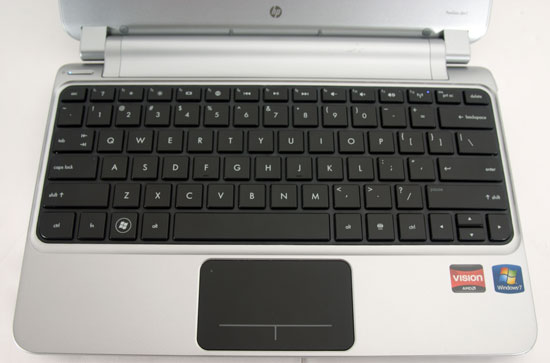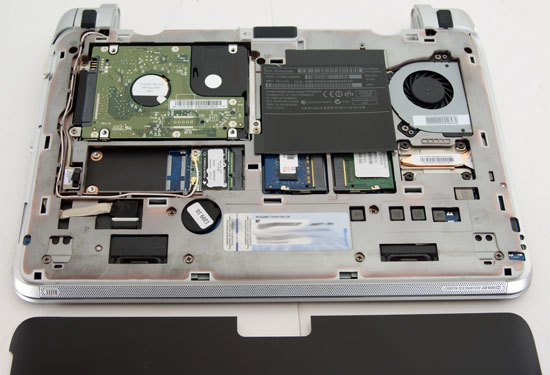HP dm1z: Taking Fusion on the Road
by Dustin Sklavos on February 21, 2011 7:00 PM ESTThe Swankiest Netbook You Ever Did See
First we should make one thing clear: the HP dm1z is basically small enough and slow enough to be considered a netbook, with most of the good and bad connotations that term brings with it. With that in mind, the dm1z is a remarkably attractive piece of kit and as you'll see, in many ways it feels like the netbook finally arriving at about the form factor and performance level it always needed to be at.
The lid of the dm1z is a textured black plastic that is a healthy stride away from the glossy plastic hell that used to plague HP's older models; it's attractive and doesn't easily pick up fingerprints and smudges, and the HP logo is nice and subdued in the lower corner. There's a silver trim that extends around the lid and into the body.
When you pop open the dm1z, you'll see that trim matched with silver matte plastics on the screen bezel and tastefully framing the keyboard and touchpad. HP has made some really great strides as of late in improving the looks of their notebooks, and the dm1z continues that trend. The silver plastic is used for the interior surface along with the battery and rim of the system and is complemented by sparse usage of white LED indicator lights.

HP has been pushing a standardized chiclet-style keyboard across all of their lines at this point, and it suits the dm1z. The 11.6" form factor allows HP to squeeze a comfortable full-sized keyboard into the unit, too, with the document navigation keys helpfully and logically mapped to Fn+arrow key combinations. The keys aren't marked that way, but it's easy enough to figure out. There's no number lock either, but I've never found the 10-key wrangled onto the main keyboard to be particularly useful. The only complaints about the keyboard are minor ones: HP, like Dell, opts to default the function keys to controls and shortcuts (though this can be toggled in the UEFI), and the left and right arrow keys are basically double-sized compared to the up and down arrows. On the whole, though, this is a solid netbook keyboard that most people should be very comfortable with.
The touchpad is more of a mixed bag, but kudos to HP for actually using a separate piece of plastic for it instead of just building the sensor into the inside panel. Of course, there's a reason for that: HP is using the same clickpad that's dogged their mainstream notebooks over the past year. To be fair the HP implementation is among the better ones used for Windows-based systems, it's multitouch capable, and the tracking surface is comfortable, but we would still rather see dedicated buttons on future refreshes. If you're using an external mouse or keep brushing the touchpad (not a problem I had in testing it), you can actually double-tap the top left corner of the touchpad with your finger to disable it; a pinpoint orange LED will glow when the touchpad is disabled.

One of my favorite features of the dm1z is actually on the bottom. HP has gone a long way towards simplifying user upgrades by simply putting one large, screwless panel on the bottom of the unit. The panel simply snaps on and off and feels both sturdy and user-friendly while also making the dm1z as a whole more attractive by hiding serial numbers and the Windows key. As you can see, everything you'd want to upgrade is easily accessible.
Taken as a whole I'll admit to being fairly smitten by the dm1z's design. It's remarkably well streamlined and clearly designed to improve the user experience while avoiding looking too chintzy or cheap. This is definitely one of the best-looking netbooks I've ever seen and it feels very solid.
















108 Comments
View All Comments
JarredWalton - Tuesday, February 22, 2011 - link
Funny thing is that I even reviewed something like that:http://www.anandtech.com/show/2503/2
$2000 ($2600 with a 1st-gen SSD) and you were still saddled with Intel's GMA X3100. Look at the performance scores in 3DMark03-06 and PCMark05; heck, it even has Cinebench 10 results in there. So today you get roughly the same performance as the old Core 2 Duo U7500, with six times the graphics performance, and about twice the relative battery life, all for one-fifth the price. That's a pretty good advancement for only three years!
swaaye - Tuesday, February 22, 2011 - link
I think that in a 11.6" form factor you can do better. With this thing you're plunking down a good amount of money for some very basic performance. and GMA X3100 is not that much of an issue for most people. But if price is all that matters, sure this is a decent choice I suppose.I'd rather see Brazos used in a 9" netbook, myself. Really take advantage of its low power consumption and heat output.
Penti - Tuesday, February 22, 2011 - link
You can, but not for 449 USD. Rember Atom netbooks costs as much if not more when they come with W7HP and Crystal HD accelerator. Especially if you want a bigger battery then some anemic 3-cell. There's even no need to special order this (bto). If you go down to ridiculous small batteries, there's literally not much of a point of it. If you want something like a ULV or normal Core i5 in it you will have to pay 250 USD just for the CPU, add 40 USD for chipset. Add in TFT-panel, motherboard pcb and associated components, wireless, hdd, battery, keyboard, touchpad, memory and case(charger etc) and it's already at about 750 for the cheapest possible configuration. Probably 800 in real world. I.e another product. Built in support for basics (today) such as H.264 and H.264 flash video acceleration is key here. Not that you almost can game on it. It replaces the dualcore higher end atom netbooks and makes them obsolete. With this setup your high-def online videos works, no matter if it's flash or netflix Sliverlight. Not so much on netbooks with atom, even with the Crystal HD accelerator. Adobe has real problems with those kinds of platforms till they have moved over to a real video oriented workflow like they are trying to do with stage video api. It solves todays needs.Hell it's even fast enough to do high res software decoded H.264 with CoreAVC. It's pretty important because you can't always muck about and reencode files and reencoding files takes a long time.
This is about filling and meeting the needs of the low-end. AMD can keep TSMC busy with these I suppose.
swaaye - Tuesday, February 22, 2011 - link
I just dumped a HP 12.1" from 2009 which had a Turion Neo X2 1.6 GHz (faster than Brazos) with a discrete Radeon 3450. The Turion was not exactly snappy and the 3450 was pretty sad overall. It was passable yes, but not really impressive. I got it as a factory refurb for $450 but they retailed for around $800.silverblue - Wednesday, February 23, 2011 - link
There's a couple of differences. Brazos supports more instruction sets as well as a faster IMC (albeit single channel). The performance difference should be slight, if anything.swaaye - Wednesday, February 23, 2011 - link
According to another look at Brazos here on Anandtech, an Athlon 64 X2 at 1.5 GHz can be over 20% faster per clock in some applications. That's not slight. Sometimes they are similar, but then other times you see 20% slower which is quite ugly. A 1.5 GHz Athlon 64 X2 is already very slow.swaaye - Wednesday, February 23, 2011 - link
I shouldn't have said per clock. The comparison was an Athlon 64 X2 1.5 GHz vs. Brazos 1.6 GHz.fshaharyar - Tuesday, February 22, 2011 - link
The build up to the fusion was very good. But I'd like to say they late by 6 months to the party.If they had intrudoced this product to the market 6 months back it would have stolen the Intel thunder and their would have been a huge shakeup in the netbook market.
But still not taking anything away from their success we will see better alternatives in the mobile market with this teck piece.
AMD will have ensure that they refresh there current gen proc. every 8-9 months.
with regards to their GPU refresh as well as plan their CPU strategy.
Hal2011 - Tuesday, February 22, 2011 - link
NBS=No Glossy ClubWould love a new, little portable but waiting till manufacturers figure out that glossy screens are absolute crap. They are only there to hide the poor screen quality and to look good in the shop. Even on a cloudy day outside the local coffee shop, you still only look in a mirror. Hey, a mirror is more portable if I needed one! A small notebook is made to be used all over the place but these can't. Am I the only one?
cosmotic - Tuesday, February 22, 2011 - link
"The only thing that hurts about using the dm1z, really, is the amount of bloatware it ships with from HP.""The only major dents in the dm1z's armor are the poor screen and constantly running fan."
"The only fly in the ointment is that while the E-350 is a step up, it's a long overdue one and it's not quite the huge one we needed." … "but we don't need more cores in the E-350; we need faster ones."
Sound's more like three problems instead of one.